Every season is photogenic in its own way. Spring brings such a dramatic change with all its leaves, grass and flowers, it has to be special. It’s the perfect time to experiment and try something new.
Even if you’ve taken spring photos many times before, take a look at these spring photography ideas and find something exciting to try.
1. Spring Photography: Pick One Prop and Go for a Walk
Spring changes the world around, bringing to us growing shoots and blooming flowers. This change allows photographers to look at their environments from different angles. They get to tell these stories afresh.
I’m not going to suggest shooting portraits because it’s obvious. You can’t go wrong with that. But you also can choose one tiny prop and try to photograph it in different areas of your city.
Say, pick a toy, a little plastic giraffe, a tiny wooden house, an IKEA dummy or a small cute panda. And try to imagine a series of adventures.
Place your prop on each blooming tree you can find. Note how your wooden house looks on a branch of a cherry blossom or among petals of flowering almond.
Place your toy panda on a branch of lilac or bird cherry. Isn’t it cute?

My example is a series I made a couple of years ago. It’s called The Smallest Blackbird. My father made a tiny wooden nesting box for me. I was photographing it every morning on my day to the office.
I tried to pick different flowers, so my imaginary blackbird wouldn’t be bored. I want to try to restart this little photo series and encourage you to try something similar.
Trust me, it’s simple and a lot of fun. Get your camera, go out and enjoy the fresh air of spring!
2. Explore the Tiny World of Flowers
If you have a garden, don’t hesitate to snip off a couple of cherry bloom or lilac sprigs to make a spring still life with a twist. Or visit a local market to find the heroes of your next shoot.

Got the flowers? Good! Now you can arrange everything as if you were shooting a traditional still life image, with glass bottles, vintage books, wooden boxes, etc.
Add something else, something tiny, a little sign that there’s a magical world neighboring with ours. This can even be a paper dinosaur, that’s actually not so difficult to cut out by yourself.
Or small swings hanging from a fragile branch of cherry bloom. Or maybe borrow a tea set from your kid and throw a tea party amidst falling petals!

Another thing you can do is cut out of a paper silhouette of a fairy, just a small girl with dragonfly wings. Place this silhouette behind a big leaf.
Use backlight as your key light and enjoy a still life with a hidden fairy! It’s as simple as that!
Spring makes us think about fairytales, little folk and other woodland sprites. They probably are coming out of hibernation too!
Imagine the stories you can tell about them. Draw a sketch, take a shot.
3. Use Spring Metaphors in Your Compositions
Spring photography is extremely rich for themes and metaphors. Take one simple flower. It can represent fragility, fading beauty or an unstoppable power of nature.
Take advantage of that. Don’t just take a snapshot of a pretty flower. Tell a story, create a narrative. Here’s a quick guide on how to do it.
The birth of a metaphor is the moment when you compare two objects that are dissimilar but have one common point. Or when you merge two themes that seem far apart but are connected in one instance.
Our first theme is obviously spring. It means we’re going to work with all the objects related to spring. You can even make a list of the spring props you already have. Everything from different types of available flowers to gardening tools.

Our second theme may be anything else you’re interested in. For example, for this shot, Music of Nature, I used music as my second theme.
I made a list of all the objects that represent music in my mind (CD, tape recorder, vinyl records, mike, stage, megaphone icon).
I decided that I need some sort of sound wave imagery. I then created a sound wave graph out of grass and tiny flowers. Voila!
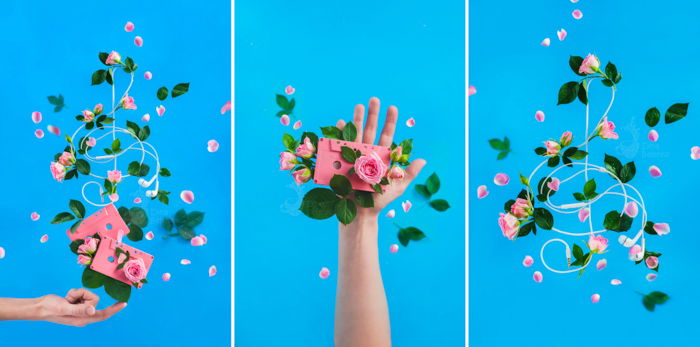
Your second theme can be anything. Pick watercolor and combine flowers with art tools, easels, brushes, and palettes. Pick jewelry and shoot flowers as precious gems.
A metaphor is a powerful tool in a photographer’s hands. Use it!
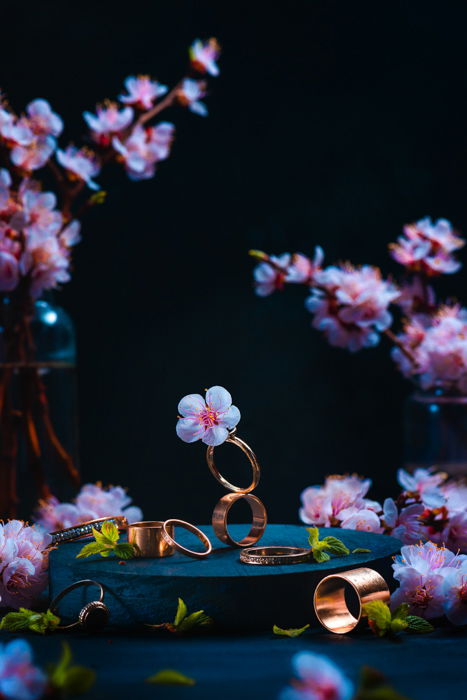
4. Take Spring Photography in the Rain
There are two major ways you can incorporate April showers in your spring photography.
First, you can brave the weather and photograph April showers and May thunderstorms as they happen. A fearless model in a bright raincoat or with a vivid umbrella is a perfect subject.
Remember to protect your camera when shooting in the rain!

You can also stay in your cozy studio and shoot spring flowers under a convincing imitation of rain. The secret is getting the background wet and filling the scene from above with a soft light.
Place your light source so you can see its a reflection in a wet backdrop.
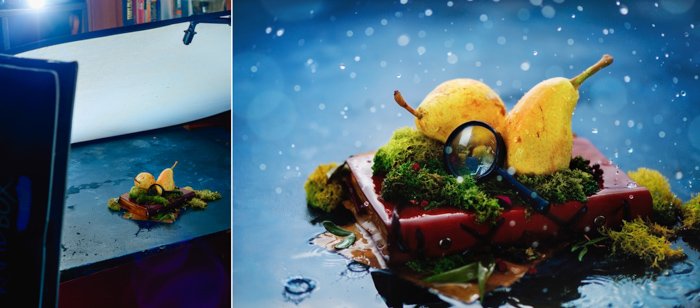
And after that, take a kitchen strainer and pour some water through it.
That way the water flow will be scattered into small drops, creating a beautiful rain effect. Simple and efficient!

You can use this rainy trick for a scene with flowers in glass vases or build a more elaborate still life with artist tools or bottles of wine. It’s up to you!


5. Experiment With Water Splashes
Water goes together with flowers, like bacon with eggs. A good way to exploit that is to shoot glass vases and jars with water splashes. You’ll create fresh and dynamic still life images with spring flowers!
I have two tips to make images like these more interesting.
Firstly, use a glue gun to fix your glass bottle in a balanced position. Or even to create a stack of jars and bottles, balancing on each other!
Just make sure that the construction is stable before you start shooting splashes.

Secondly, glue everything to the backdrop and turn it 90 or even 180 degrees. That way you will get unusual splashes that will appear to defy gravity.


Capturing the right splash may be challenging, but the resulting photos are totally worth it.
Check out previous tutorials on splash photography to get started.

6. Incorporate Themes Like Growth and Change
Spring marks the start of new things. It symbolizes growing and changing. Foliage is in bloom, animals are coming out of hibernation and birds are back from migration.
Reflect this time of change in your photography.
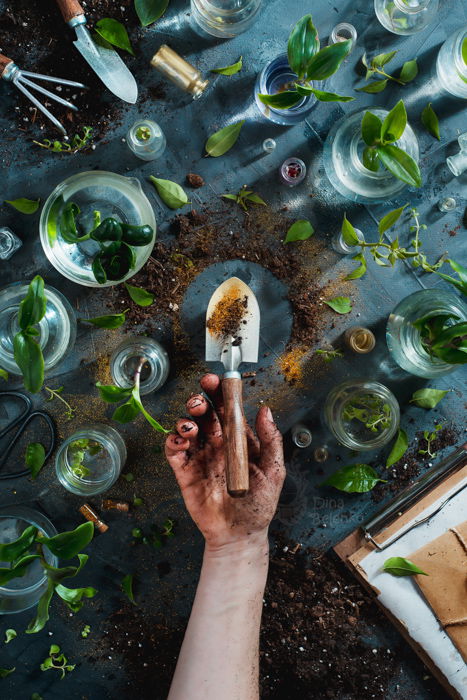
First of all, think about gardening. New sprouts and first flowers in a company of gardening tools like small watering cans and scissors.
Shoot a flat lay with hands covered in earth, with tender petals and ceramic pots. Photograph your friend with a green thumb with their new plants. Show how things start to be alive again after winter.

Another way to do it is to take ‘change’ more literally. Think about repairs in the house. Draw parallels with spring.
Arrange a minimalist flat lay with brushes or paint rollers covered with different types of newborn flowers!

Or you can reflect on what spring means to you personally and show in in your pictures.
7. Combine Flowers and Food Photography
Food (especially desserts!) look gorgeous with an addition of flowers as a beautiful accent. Add some lilac to your flat lay with purple macrons.
Pair apple blossom with an apple pie. Or combine a branch of cherry flowers with tender white cupcakes!


If you want to step up your game, shoot your favorite dessert as a flower. Take a small bouquet and replace all the flower except little buds with cupcakes. Or place a macaron in the center of a flower.

8. Create Spring Crafts With Letters
Dimensional typography is even more fun when you have leaves and petals to play with! Beautiful texts made from flowers look tender, fragile and very touching.
Think about a short but lovely sentence. Write its contour with a pencil on your background and trace it with small green leaves, gentle flowers, and fallen petals.

Another way is to cut the letters out of paper and arrange flowers beneath them.
This is simpler and the risk that your message won’t be readable is lower. But the result may not look that elegant.
One more way is to use a paper template. Print the text you want to use and cut it from a sheet of paper with a layout knife.
Fill the template with earth, pollen or very tiny petals. Anything free-flowing will work.
Carefully remove the template with tweezers and arrange the rest of the composition. And finally, photograph the remaining letters.

9. Photograph Floral Flat Lays
Having flowers in the frame and getting a dull image is practically impossible. Don’t be afraid to incorporate the first flush of spring into your flat lay.
Try to say something with your photo. Think about the character, the place and the meaning of your shot.

For example, any pink flowers are perfect for a flat lay with a love letter. Just get a pink envelope and some pink stationery as a pretty accent, arrange a simple composition and take a picture.
Or think about the author of romantic novels. Place a typewriter and crumpled paper balls into a frame. Maybe your character is an artist who’s about to paint a branch of cherry blossoms and they already have their watercolors ready.
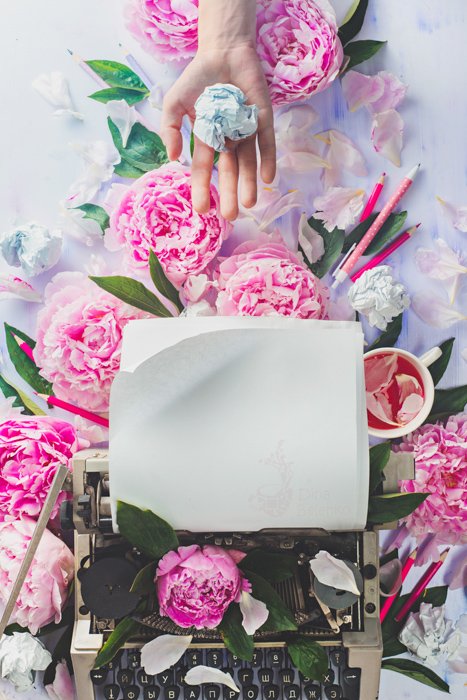
All these scenes would look gorgeous in a flat lay, so why not try it right now? There’s basically no chance for error.
Conclusion
Stay alert to your surroundings, take some time to enjoy the beauty of awakening nature and don’t be afraid to experiment. Stay inspired and good luck!
Why not check out these unique animal photography examples to inspire you next!


